Recruitment marketing is becoming more crucial than ever for all businesses, big and small.
There are more job opportunities for top talent now, especially with the shift to mainstream remote work since larger employers can now hire anywhere.
Finding and hiring qualified candidates is difficult. In fact, the process has turned upside down:
Recruiters no longer select the candidates. It’s the candidates who get to choose employers.
If organizations want to attract the top talent, they have to embrace recruitment marketing alongside their employer branding. Even MI5 (the UK Spy Agency) has taken to Instagram in an effort to appeal to job applicants.
In this guide, you’ll learn what recruitment marketing is and how you can implement a winning recruitment marketing strategy for your organization.

Manage all your social media accounts in one place.
Craft, schedule, & auto-post content to all your social channels, then track analytics and manage interactions from a single, easy-to-use dashboard.
What is Recruitment Marketing?
Recruitment marketing uses marketing strategies to promote the benefits of working for your company – your Employer Brand and Employee Value Proposition – to find, attract, engage, and nurture leads – i.e. potential job candidates for future hiring needs.
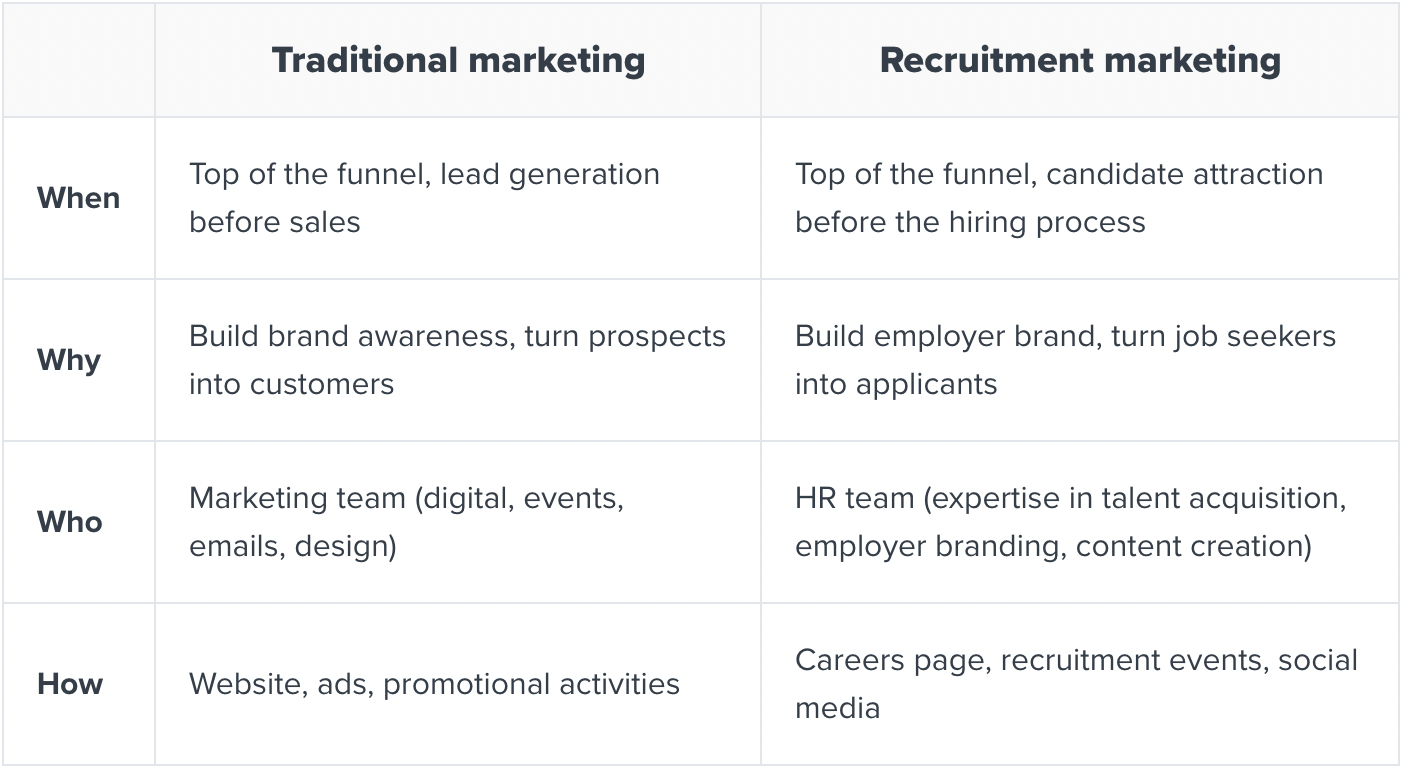
Source: Workable
In short, recruitment marketing adopts traditional marketing methodology to promote the employer brand and hire candidates.
Recruiting vs recruitment marketing
Recruiting is focused on specific current hiring requirements. On the other hand, recruitment marketing aims to promote the company as an appealing employer to encourage future hiring.
This side-by-side comparison explains the differences:
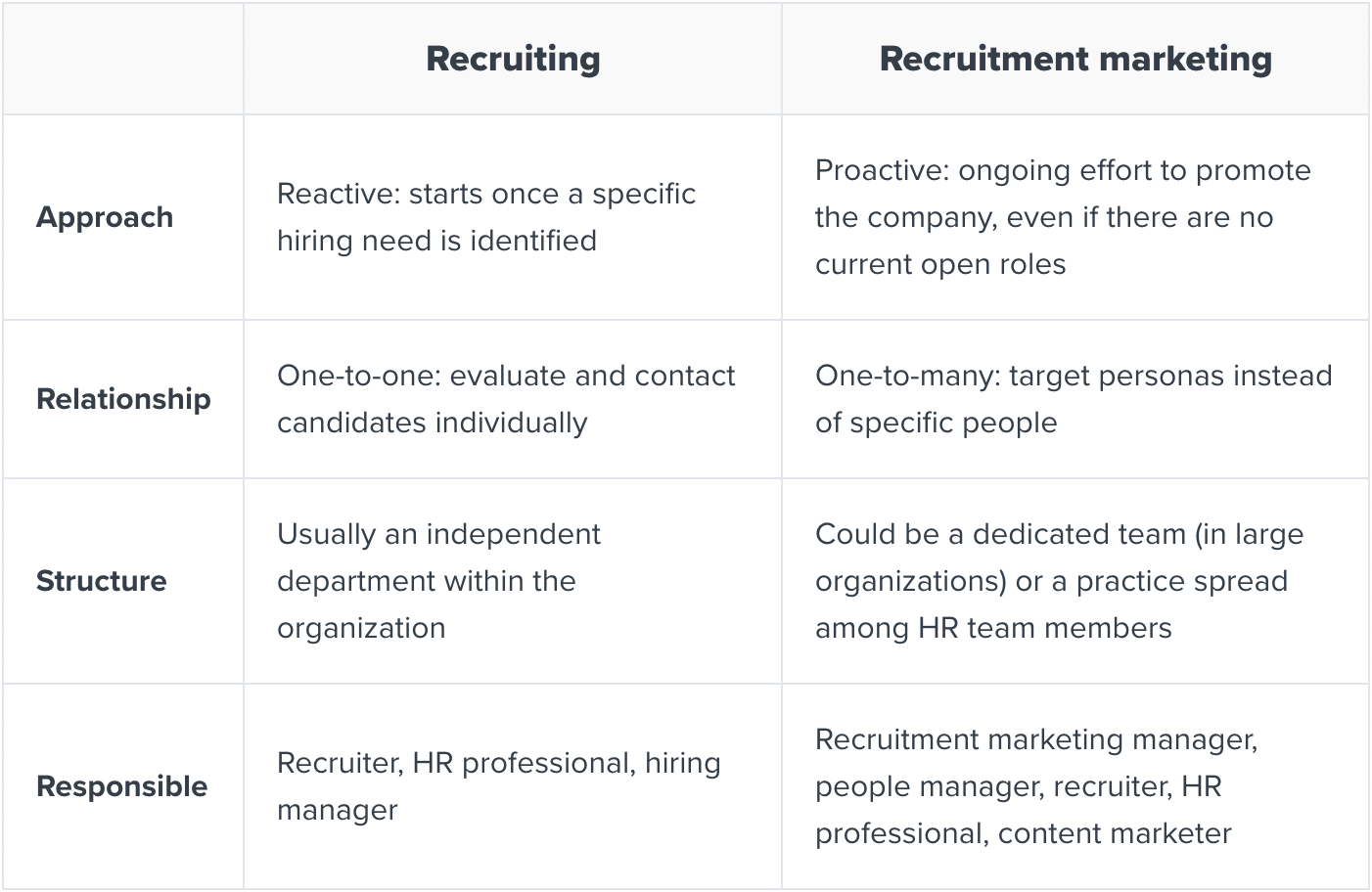
Source: Workable
Why Recruitment Marketing Matters for Your Organization
Here are three reasons why your organization needs to embrace recruitment marketing.
1. Traditional recruitment methods are no longer effective
In today’s candidate-driven job market, it’s not recruiters who select candidates anymore. It’s the candidates who get to pick and choose.
Because of this, it is more challenging than ever for recruiters to find and hire qualified candidates. To gain their trust and convince them to choose you over your competitors, you need to synchronize your marketing and recruitment efforts.
According to SHRM, organizations that employ recruitment marketing techniques can generate three times more leads, 10% more revenue, and a 100% higher close rate than those who don’t.
2. Candidates are consumers
Today’s candidates discover and consider employers the same way consumers find products and services.
They search online, follow social media updates, and read reviews, to build a picture of a prospective employer and its career opportunities.
Monster discovered that 90% of candidates start their job search online and spend up to four hours researching employers before ever applying. Of these, 65% reported that the company career site was the most helpful resource while doing their research.
For instance, what they learn about a company’s mission and culture could encourage them to apply for a job and accept an offer or create a negative perception about the brand.
3. Recruitment marketing is measurable
Employers find traditional recruitment hard to measure. But recruitment marketing provides metrics like cost per qualified applicant, top-performing traffic sources, and social media reach so that employers can test and adjust their campaigns accordingly.
For example, research by Allegis found that running a recruitment marketing campaign can save companies up to 40% on total talent costs. Furthermore, recruitment marketing boosts the employer brand and attracts an estimated 50% more qualified candidates.
Examples of Successful Recruitment Marketing Campaigns
Here are three examples of successful recruitment marketing campaigns, from straightforward to ingenious.
Marriott’s Career Pages
Marriott is an excellent example of a company doing recruitment marketing the right way. Its Facebook Careers Page has over 1.3 million likes, and its LinkedIn Page has over 1.6 million followers.
They consistently publish content that potential employees can relate to and feel inspired by, such as employee achievements, days in the life of an employee, and general day-to-day updates from across the Marriott network.
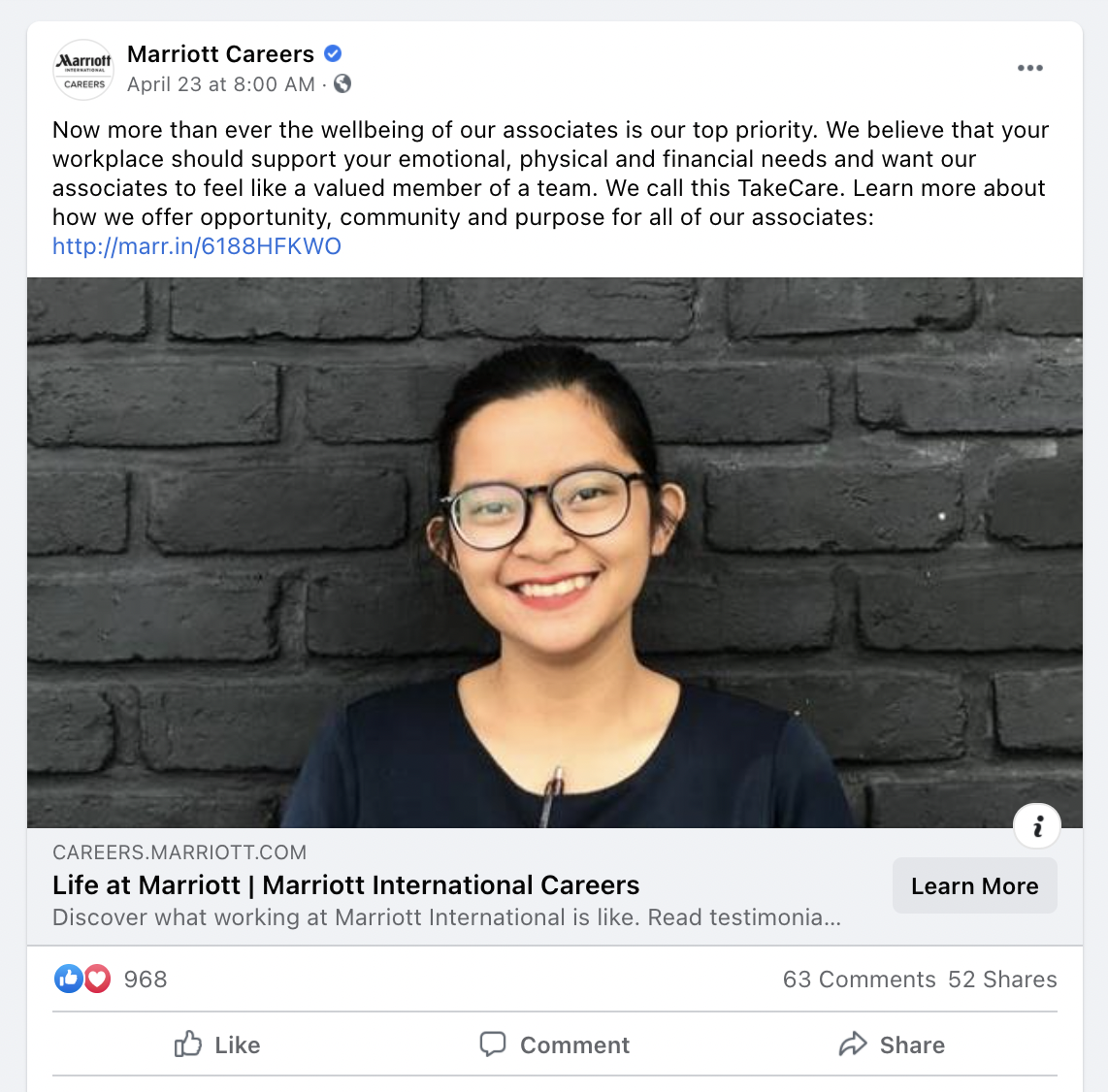
Source: Marriott (Facebook)
The hotel chain replies to any questions and comments, and they also have a chat service where interested parties can learn more about life at the company and how to apply for a job successfully.
Marriott’s strategy is straightforward: use a dedicated space where you share insights on life at your company and, most importantly, engage with potential candidates by replying to their questions promptly and efficiently.
Eurowings Airlines’ Perfect Match
The user experience (UX) of apps and websites can make a massive difference in whether users stick around or leave. Recruitment marketing campaigns use the same UX principles. By designing an engaging and interactive campaign using a mobile app or social media, you can urge more candidates to apply.
Eurowings took this approach for its recruitment marketing campaign. It based its job posts on the top-rated Tinder dating app, where job seekers could either swipe left or swipe right.
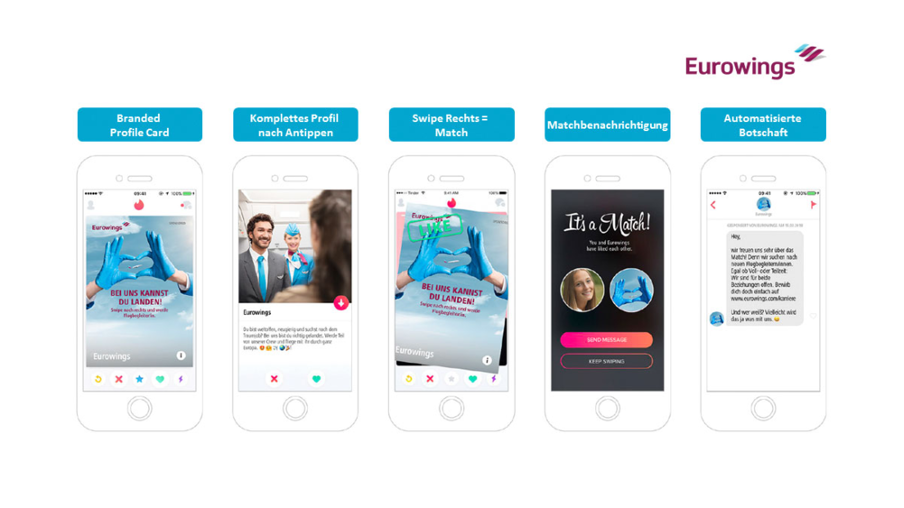
Source: The Employer Brand Shop
If applicants swiped right, they got the “It’s a match” message (just like the dating app) from Eurowings, plus further information on the advertised job and a link to the Eurowings careers website.
During the two-month campaign, Eurowings reached more than 600,000 users in the catchment areas of Munich, Stuttgart, and Austria, with an engagement rate of 9.8% and visits to the careers page increasing by almost 40%.
IKEA’s Career Instructions
One of the most famous, creative recruitment marketing campaigns is IKEA’s Career Instructions.
IKEA wanted to fill 100 positions at its brand new Australian mega store with a direct yet cost-effective approach.
IKEA’s “outside-the-box” thinking led to a fantastic “inside-the-box” solution.
They placed career instructions – i.e. job descriptions for open positions – in every product box. The career instructions mirrored their famous assembly instructions, and informed customers how to “assemble your future”.
The reason this campaign worked so well is that IKEA targeted people who were already familiar with the company and brand – i.e. their customers and brand ambassadors.
IKEA also saved thousands of dollars as they didn’t have to hire an agency or advertise jobs on existing media channels.
Instead, they connected with candidates in a personalized way, in their own homes just as they focused on assembling their new furniture.
The campaign was a huge success – IKEA received 4,285 quality applications and made 280 hires.
How to Implement a Winning Recruitment Marketing Strategy
Follow this five-step framework to implement a winning recruitment marketing strategy for your brand:
- Set your recruitment marketing goals
- Plan and produce your content
- Collaborate with your cross-functional team
- Engage with your audience
- Measure your performance
Before we start on the recruitment marketing strategy, there’s one essential prerequisite you need in place – employer branding.
Prerequisite: Employer Branding
Employer branding is how you attract and engage potential employees and make the prospect of working for your business truly exciting.
The process involves promoting your organization as the employer of choice to your desired target market.
Statistics show that 72% of employers believe employer branding has a significant impact on the hiring process, and 75% of candidates take an employer’s brand into account before even applying.
By telling an authentic story about what it’s like to be a part of your company and work toward your mission, you can entice candidates who think and feel and strive for the same.
With that sorted, let’s move on to the recruitment marketing strategy.
Step 1. Set your recruitment marketing goals
Like any marketing strategy, always start by setting your goals and defining your target market.
Set specific SMART goals
Your recruitment marketing strategy must have goals so that you can measure your progress and adjust tactics along the way, as you’ll see later in Step 5.
Using a SMART goal means you have an achievable target to work towards, and you can measure its success. For example:
“We want to attract 100 qualified entry-level candidates by the end of Q3 2021.”
Make sure your recruitment marketing goals align with your overall business objectives.
Define your target market
In recruitment marketing, your target market is your ideal job candidate. As you recruit for different roles, your ideal candidate will vary.
For example, your ideal candidate for a VP of Marketing position is totally different from an employee in your distribution center. So you’ll have to create a talent pool for different roles.
However, there will be an underlying core set of values and types of personality that you’ll want to target based on your company profile.
Ensure you consult with the hiring team and future colleagues on their ideal target candidate and the attributes to look for in the application process.
When you think of your ideal target candidate, ask yourself:
- Are you trying to hire Gen X, Millennials, or Baby Boomers?
- Are you recruiting for a particular skill or someone with specific experiences or education?
Then you can tailor your channel and message accordingly.
Step 2. Plan and produce your content
Now that you’ve defined your goals and target market, you can start to plan your content. At this stage, you need to identify your marketing channels, allocate resources, and create a content calendar.
Identify your marketing channels
By establishing your target candidates, you’ll know where to find them and how to attract them. Research their background, experience, and demographics to discover which platforms they prefer to use.
Today’s candidates are digitally savvy and use social media to research potential employers.
- 79% of job candidates use social media in their job search:
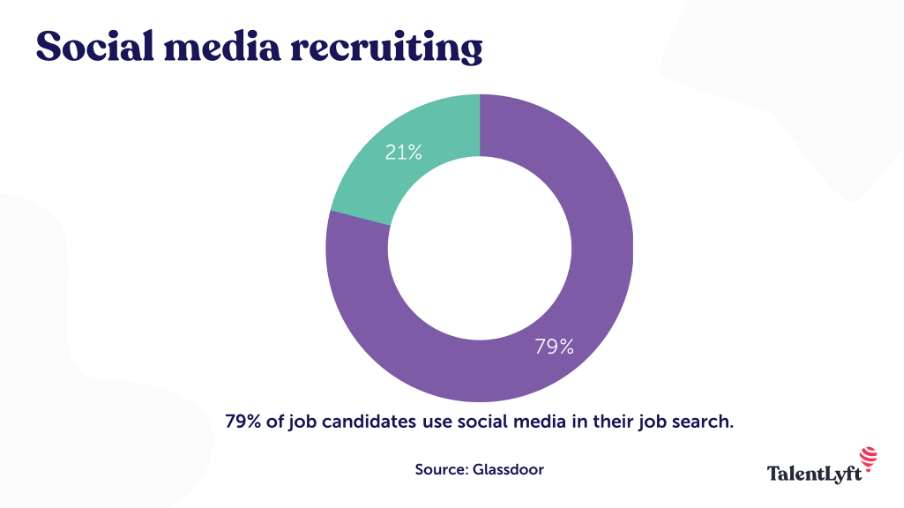
- 73% of Millennials found their last job through social media:
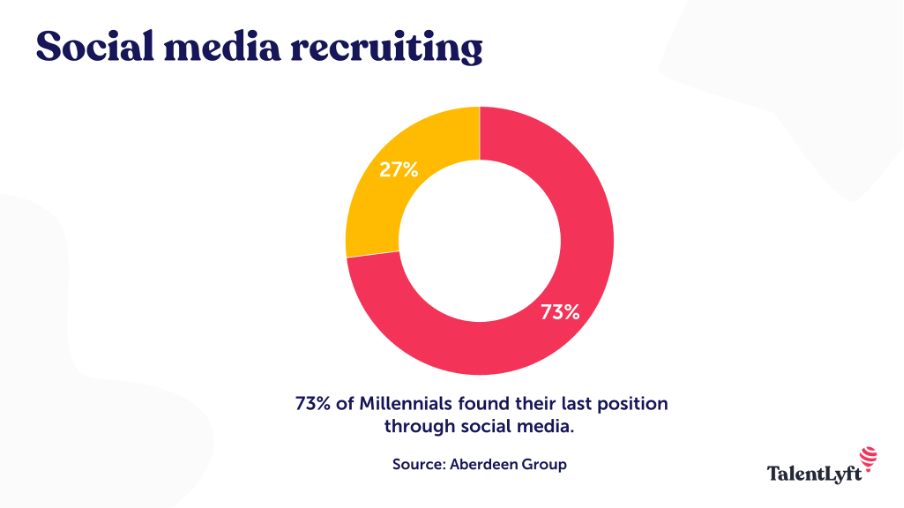
But, you’re not limited to social media.
Here are some other channels to consider:
Careers website: still the hub of your recruitment marketing activity – 65% of job seekers found the career site the most helpful resource. Include photos and videos to attract candidates and inform them of your company culture.
Content marketing: including blogs, company photos, recruiting videos, infographics, ebooks, and webinars.
Email nurturing: using automated and personalized messages and measuring open rates, click-through rates, and response rates.
Social media: attracting candidates with company photos and videos, creating a unique hashtag for your open jobs, and tracking social media analytics.
Job postings and job boards: posting jobs where your target candidates will be found, including photos and videos to attract candidates.
Employee referral program: train your employees on your employer brand and recruitment plan to become brand ambassadors.
Display advertising: creating awareness of your company’s employer brand by advertising to passive candidates.
Talent communities: keeping a pipeline of qualified candidates engaged by subscribing to your blog or newsletter, following your social media channels, and participating in special offers and contests.
- Candidates whose skill set and experience currently don’t fit.
- Candidates who are interested in future opportunities.
Recruitment events: career fairs and meetups.
Whichever channels you use, always convey your company’s culture and mission authentically.
Allocate resources
You’ll have a limited budget that you need to maximize. Consult with your marketing team to get some insights into where their marketing efforts are successful. For instance, are they using paid or organic social media? Are they using in-house or external resources to create content?
Create a content calendar
A large portion of your resources will need to go towards content creation. The better quality content you create, the better candidates you’ll attract. To ensure you get a cohesive and consistent story that unfolds with every post, create a content calendar so that everyone can see the planned publishing dates.
Candidates rarely apply on their first encounter with your brand, so you’ll have to create a library of content that speaks to them throughout the job search.
Step 3. Collaborate with your team
Recruitment marketing isn’t limited to one department – it involves people from departments including HR/ Talent Acquisition, Hiring Manager, and Legal. To ensure you publish only on-brand, proofread, appropriate, and compliant content, use workflows to collaborate with your cross-functional team efficiently. Make sure you get review and sign-off from all parties.
Step 4. Engage with your audience
Your recruitment marketing doesn’t end when you publish your content. A key aspect of your strategy should involve engaging with your audience – i.e. your target candidates.
On social media, you can interact through comments and messengers.
On your career website, consider using a lead capture form so that you can keep in touch with potential candidates via email. Don’t ignore them once they’ve shown an interest in your company. Engage with them. Chat with them. Invite them to follow-up sessions, like a webinar, where they can learn more about your organization.
Step 5. Measure your performance
Finally, it’s time to measure your recruitment marketing performance. At this stage, you can circle back to your goals to see if you achieved them.
You can also evaluate the response of your target audience to the content you published to learn what resonates with them, and then adjust and fine-tune your strategy accordingly.
Recruitment marketing metrics
Here are some of the recruitment marketing metrics you may choose to measure:
- Cost-per-applicant: your recruitment marketing spend divided by the number of applicants.
- Cost-per-hire: your recruitment marketing spend divided by the number of hires.
- Visitors-to-applicants ratio: the number of applicants divided by the number of visitors to your website.
- Benchmark: The industry average conversion rate from website visitors to applicants is 11%.
- Applicants-to-interviewees ratio: the number of applicants divided by the number of interviewees.
- Benchmark: the industry average conversion rate from applicants to interviewees is 12%.
- Interviewees-to-offers ratio: the number of offers divided by the number of interviewees.
- Benchmark: the industry average conversion rate from interviewees to offers is 17%.
- Offers-to-hires ratio: the number of hires divided by the number of offers.
- Benchmark: the industry average conversion rate from offers to hires is 89%.
- Time-to-hire: the number of days it takes to hire someone.
- Benchmark: the industry average time-to-hire is 41 days. And the average time top performers are on the job market is 10 days.
- Quality-of-hire: the retention rates and performance ratings of new hires.
Recruitment Marketing in a Nutshell
Recruitment marketing adopts traditional marketing methodology for hiring purposes. It promotes the employer brand rather than the commercial brand, and then attracts, engages, and nurtures ideal candidates.
Follow this five-step framework to implement a winning recruitment marketing strategy for your brand:
- Set your recruitment marketing goals
- Plan and produce your content
- Collaborate with your cross-functional team
- Engage with your audience
- Measure your performance



